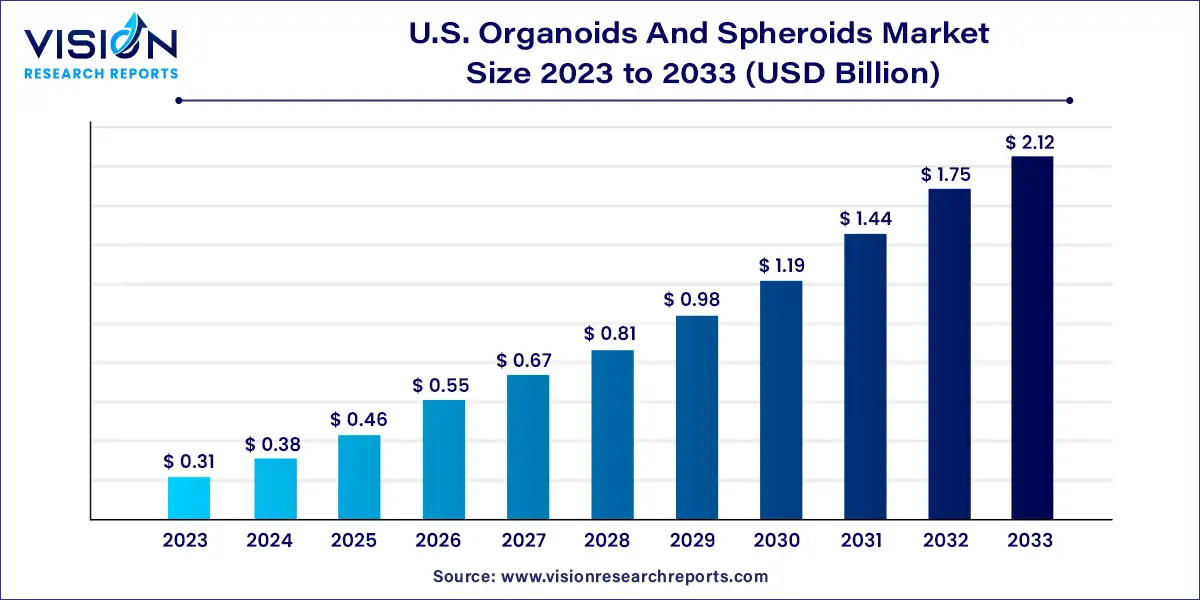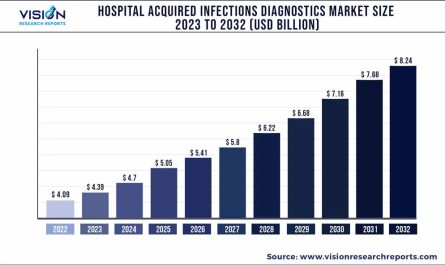The U.S. organoids and spheroids market size was estimated at around USD 0.31 billion in 2023 and it is projected to hit around USD 2.12 billion by 2033, growing at a CAGR of 21.17% from 2024 to 2033.
Organoids and spheroids represent advanced in vitro models that mimic the structure and function of human organs and tissues, offering significant potential in drug discovery, disease modeling, and personalized medicine. In the United States, these technologies are gaining prominence for their ability to bridge the gap between traditional cell culture models and complex biological systems.

Key Pointers
- By Type, the spheroids segment held the largest revenue share of 53% in 2023.
- By Type, the organoids segment is expected to expand at the highest CAGR from 2024 to 2033.
- By Application, the developmental biology segment generated the maximum market share of 31% in 2023.
- By Application, the regenerative medicine segment is anticipated to grow at the noteworthy CAGR from 2024 to 2033.
- By End-use, the biotechnology and pharmaceutical industries segment captured the maximum market share of 48% in 2023.
Get a Sample@ https://www.visionresearchreports.com/report/sample/41356
Drivers of the U.S. Organoids and Spheroids Market
- Advancements in Biotechnology: Continuous innovations in 3D cell culture techniques and biomaterials enable the development of organoids and spheroids that closely resemble human tissues.
- Drug Discovery Applications: High-throughput screening using organoids and spheroids accelerates drug discovery by providing more accurate predictions of drug efficacy and toxicity compared to 2D cell cultures.
- Personalized Medicine: Growing emphasis on personalized therapies drives the demand for patient-derived organoids and spheroids for disease modeling and treatment optimization.
- Rising Prevalence of Chronic Diseases: Increasing incidence of chronic diseases such as cancer, cardiovascular disorders, and neurodegenerative diseases fuels research into more clinically relevant model systems.
- Investments and Funding: Supportive funding from government agencies, private investors, and pharmaceutical companies propels research and development initiatives in organoid and spheroid technologies.
Challenges Facing the Market
- Complexity and Variability: Variability in organoid and spheroid cultures poses challenges in standardization and reproducibility of experimental results across different laboratories.
- Cost of Implementation: High costs associated with establishing and maintaining organoid and spheroid cultures limit adoption, particularly in academic and smaller research institutions.
- Technological Limitations: Challenges in scaling up production, maintaining long-term viability, and integrating multi-omics analyses constrain the widespread application of organoids and spheroids.
- Ethical Considerations: Ethical concerns regarding the use of human-derived organoids and spheroids, especially those sourced from patient biopsies or stem cells, require careful consideration and regulatory oversight.
- Educational and Training Needs: Addressing the skills gap in culturing, manipulating, and analyzing organoids and spheroids is essential for advancing research capabilities and market growth.
Trends Shaping the Market
- Advancements in Biomaterials: Development of novel biomaterials and scaffolds enhances the functionality and complexity of organoids and spheroids, replicating physiological conditions more accurately.
- Integration of Technologies: Combined use of organoids/spheroids with technologies such as CRISPR/Cas9 gene editing and single-cell RNA sequencing enables comprehensive characterization and manipulation of cellular models.
- Application Expansion: Beyond traditional disease modeling and drug screening, organoids and spheroids find applications in toxicology studies, regenerative medicine, and understanding host-pathogen interactions.
- Commercialization Efforts: Increasing partnerships between biotechnology firms, academic institutions, and pharmaceutical companies drive the commercialization of organoid and spheroid technologies.
- Regulatory Advancements: Evolving regulatory frameworks and guidelines for the use of organoids and spheroids in drug development and clinical research facilitate market entry and product approvals.
Read More@ https://www.heathcareinsights.com/u-s-spatial-genomics-transcriptomics-market/
U.S. Organoids and Spheroids Market Key Companies
- Thermo Fisher Scientific, Inc
- Sigma-Aldrich Co. LLC
- 3D Biomatrix
- Corning Incorporated
- 3D Biotek LLC
- Perkin Elmer, Inc.
- Prellis Biologics
- Danaher
- Aragen Bioscience
- Cell Microsystems
Recent Market News
- In February 2024, Cell Microsystems forged a partnership with OMNI Life Science to introduce groundbreaking cellular analysis solutions to North America. This collaboration aims to unveil three pioneering products – CERO, CASY, and TIGR – in the United States and Canadian markets.
- Similarly, in February 2024, Danaher revealed a collaboration with Cincinnati Children’s Hospital Medical Center with the goal of bolstering patient safety during early drug development stages. This joint effort focuses on developing innovative technologies centered around liver organoid technology for drug toxicity screening. The ultimate objective is to expedite the development of new therapies and potentially reduce substantial research costs.
U.S. Organoids and Spheroids Market Segmentation:
By Type
- By Type
- Organoids
- By Type
- Neural Organoids
- Hepatic Organoids
- Intestinal Organoids
- Other Organoids
- By Method
- General Submerged Method for Organoid Culture
- Crypt Organoid Culture Techniques
- Air Liquid Interface (ALI) Method for Organoid Culture
- Clonal Organoids from Lgr5+ Cells
- Brain and Retina Organoid Formation Protocol
- Other
- By Source
- Primary Tissues
- Stem Cells
- By Type
- Spheroids
- By Type
- Multicellular tumor spheroids (MCTS)
- Neurospheres
- Mammospheres
- Hepatospheres
- Embryoid bodies
- By Method
- Micropatterned Plates
- Low Cell Attachment Plates
- Hanging Drop Method
- Others
- By Source
- Cell Line
- Primary Cell
- iPSCs Derived Cells
- By Type
- Organoids
By Application
- Developmental Biology
- Personalized Medicine
- Regenerative Medicine
- Disease Pathology Studies
- Drug Toxicity & Efficacy Testing
By End-use
- Biotechnology and pharmaceutical industries
- Academic & Research Institutes
- Hospitals and Diagnostic centers
Buy this Premium Research Report@ https://www.visionresearchreports.com/report/checkout/41356
You can place an order or ask any questions, please feel free to contact sales@visionresearchreports.com| +1 650-460-3308

